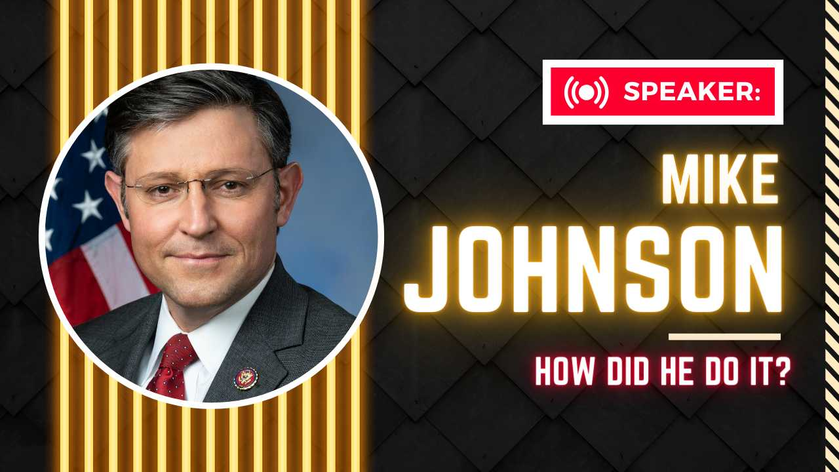Many are calling the election of Rep. Mike Johnson (R-La.) as Speaker of the House of Representatives, a miracle. Others are calling it a nightmare, and will continue calling it a nightmare. These others fall into two categories. One expects no better of the socialist, anti-procreative, “woke” left. But the other side are the RINOs (Republicans In Name Only) and “the appropriators.” These are the sort of legislator who gets rich from the public weal. Until now, “appropriators” of both parties have fooled their constituents with ideological lip service. They’re not fooling anyone any more, it seems – and now the Republican “appropriators” suffered their greatest setback.
It began with a Continuing Resolution
It all began with a Continuing Resolution, which passed on September 30 – the end of the Fiscal Year. (Rep. Jamaal Bowman, D-N.Y., made a big show of delaying the proceedings with his fire-alarm stunt. The Justice Department, no doubt knowing that he did it for show, have charged him with a misdemeanor.) Rep. Kevin McCarthy (R-Calif.), Speaker of the House, was the architect of that Continuing Resolution. This made Rep. Matt Gaetz (R-Fla.) furious – because McCarthy had promised he would do no such thing. That is why Gaetz and his allies ultimately let McCarthy become Speaker, by voting “Present” instead of for another name.
Gaetz had already threatened McCarthy with a Motion to Vacate the Chair if he broke any more of his promises. Now, Gaetz had to do it – and he did. The next day, Gaetz, Rep. Nancy Mace (R-S.C.), six other Republicans – and 208 Democrats – voted “Aye” on the motion. McCarthy made a concession speech that sounded gentlemanly – but would turn out to be insincere.
https://twitter.com/SpeakerMcCarthy/status/1709349632315199968
Rep. Patrick McHenry (R-N.C.), Speaker pro tempore, recessed the House with a violent gavel stroke that almost chipped the dais. And for three weeks, McHenry would be a temporary presiding officer with no power other than to preside over the election of another Speaker.
A series of failures
Speculation – all vain – centered on a bid to make Donald J. Trump Speaker of the House. That would vest him with subpoena power, so he could strike back at his prosecutorial persecutors. But no one but a member of the House has ever become Speaker of the House. Many experts make a good argument that the Speaker must be a Member.
But Trump was one of three men who emerged as viable candidates for the job. The other two were Reps. Jim Jordan (R-Ohio) and Steve Scalise (R-La.), the Majority Leader. Trump endorsed Jordan – but Steve Scalise became first to win nomination. But within two days, he bowed out of the race. He knew he would not have the votes to prevail on the House floor.
After that, the House Republican Conference nominated Jordan. But then they held a test vote to see how many would commit to supporting Jordan on the House floor. Only 155 Members so voted. After that, a plot by RINOs to sabotage Jordan’s candidacy became apparent. What was not apparent was who was doing it, and exactly why.
Despite picking up some surprise endorsements, Jordan lost on the House floor. After first one, then a second, roll-call vote, Steve Bannon (Bannon’s War Room) charged that K Street lobbyists were actively working against Jordan. He based his charge on intelligence from his own operatives who overheard conversations in one of Washington’s favorite “power restaurants.” Jordan lost the third round, and the Conference withdrew its nomination.
First Tom Emmer – and then Mike Johnson
Over the next few days, another round of declarations took place. On Tuesday (October 24), Rep. Tom Emmer (R-Minn.), Majority Whip, won the nomination. And that, from the point of view of K Street and the “appropriators,” is when things started to go wrong.
Donald Trump angrily posted to Truth Social to tell the Conferees not to support Tom Emmer on the floor. That might, or might not, have been the catalyst. Even before Trump made that post, twenty-six Republicans already had lined up to oppose Emmer.
https://twitter.com/TheCalvinCooli1/status/1716878615919669714
Rep. Anna Paulina Luna (R-Fla.) put in her two cents seventeen minutes after that:
https://twitter.com/realannapaulina/status/1716883229322719673
Then the first “buzz” started about Mike Johnson winning the nomination. Mike Johnson had in fact come in second to Tom Emmer after five ballots by noon that day.
https://twitter.com/JakeSherman/status/1716887973554499939
This much Jake Sherman, who had to stay outside the meeting room, knew. At 4:00 p.m. EDT, the Conference met again, in the Longworth House Office Building. Twenty-two minutes into the meeting, Emmer stormed out, without saying a word.
https://twitter.com/JakeSherman/status/1716913278356774924
So once again the Conference took declarations of candidacy. At 8:00 p.m. EDT they started to vote again. After three ballots, Mike Johnson won the nomination. But 43 Republicans cast write-in votes on that third ballot, after 34 had voted against him in the second. Nevertheless, he had a majority – but would the support stick with him?
It did. Incredibly Mike Johnson won the floor vote, with the entire Conference, except one absent member, voting for him.
How Mike Johnson did it
After the vote, Nancy Mace shared this post on X, congratulating Mike Johnson on his election. She also shared credit with Gaetz and the other six “Aye” votes on the Motion to Vacate, for this outcome.
https://twitter.com/RepNancyMace/status/1717238665305301319
Rep. Gaetz told Steve Bannon how that marathon nomination session had gone, on the morning before the floor vote. Today, Nancy Mace revealed more. The Gateway Pundit’s Jim Hoft published two articles quoting these interviews, one for Gaetz, the other for Mace. Their Rumble channel also carried excerpts from those interviews:
https://rumble.com/embed/v3p08ky/?pub=4teej
https://rumble.com/embed/v3p8gfs/?pub=4teej
Matt Gaetz revealed first what some had suspected. The K Street lobbyists definitely sabotaged Jordan – but not Jordan alone! Nor, says Gaetz, were they acting on their own initiative. Kevin McCarthy was trying to reclaim the Speakership the whole time. Nancy Mace would confirm that the next day. She said this to Steve Bannon:
This thing didn’t need to last through three weeks. So the first thing that McCarthy and his allies did was prolong it and delay it and recess us and adjourn us every time they possibly could to drag this thing out and make it as painful as possible. For the eight of us who held the line and kicked McCarthy out of the speakership, that’s number one. Number two, there was a concerted and orchestrated effort at the hand of McCarthy that every time someone ascended, they got knifed in the back, including America’s favorite Republican congressman in Jim Jordan. I mean, our conference couldn’t even elect the best and favorite congressman in this country, Jim Jordan, because of what McCarthy and his allies were doing behind the scenes and orchestrating his failure.
And that of Steve Scalise. But Tom Emmer was never a sincere candidate, but was in fact McCarthy’s decoy. Matt Gaetz provided far greater detail:
The chapter of this that was dispositive, the crescendo, begins as Tom Emmer is withdrawing from the race [October 24]. I told Emmer on Sunday that he was not going to get there – that he was going to move like a hot knife through butter through the first 80 percent of the Conference. But … there was going to be a series of votes that were never going to be there for him. He wanted to run through it. I said, “Tom, here’s the deal. You can have your own way, but when you get to that last group that will not support you, you cannot drag this on for days, you cannot drag this on for weeks, you cannot play into what Kevin McCarthy was working the whole time, to get people to believe that the only person who could govern the Republican Conference was Kevin McCarthy.” So Emmer agrees that he’s going to have his shot, but it’s going to be quick.
It was quick, all right – about four hours and twenty minutes, give or take ten. And then:
We get that through the Gestation system early yesterday. So as Emmer is withdrawing, Mark Molinaro, a moderate New York freshman Republican, stands up at the microphone and says, well, instead of restarting this process and having a candidate forum and sending everybody home for a good cry, let’s just take a non binding poll on where people would be on the person who came in second to Tom Emmer, and that was Mike Johnson. And Elise Stefanik said, well, that’s against the rules. The rules don’t contemplate it. We can’t do that.
And brilliantly Mark Molinaro says, then I move for unanimous consent that the rules be [suspended], and we take a poll on whether or not Mike Johnson could be our Speaker nominee.
That explains this post by Jake Sherman:
https://twitter.com/JakeSherman/status/1716918257184362522
But wait!
And guess who objects to that unanimous consent request? — Kevin McCarthy! Kevin McCarthy stands up and says, I object to doing a roll call on Mike Johnson.
And when he did that, he gave the game away:
And Mike Johnson was exasperated. All the times Johnson had voted for McCarthy, had carried his water, maybe even voted for some bills he didn’t like because he was working toward the Republican conference’s stated objectives under McCarthy. And here was the thing — It showed everyone that it was actually McCarthy who was working to knife Scalise. It was actually McCarthy who was working to knife Jim Jordan. It was McCarthy working to knife everyone, and he hadn’t yet figured out a way to knife Mike Johnson. And so he was worried that there was going to be this great unifying moment, and he scuttled the unifying moment.
So what next?
So because of McCarthy’s objection, we had to have this three hour delay, and candidates announce again, have another forum. And guess what happens during that delay, Steve? Patrick McHenry runs to the House floor, opens it up out of recess, and then adjourns till noon today [October 25]. Now, why did he do that? Because they were setting up a play to block Mike Johnson with write in votes in the intra-conference process for Kevin McCarthy.
They were promising people hearings on their favorite legislation, passage of bills. I heard people promised, oh, maybe you’ll get a chairmanship. And the play was for McCarthy to return as speaker and then Jim Jordan to be the deputy speaker in some sort of way, like, Dwight Schrute assistant to the regional manager posture. And that would have been debasing to Jordan, someone I like a great deal, and it would have been empowering to McCarthy.
Dwight Schrute is a fictional character on the television series The Office. He is the typical Number Two trying to become Number One through dutiful service.
Gaetz went on:
So Garrett Graves and all these people are working to try to effectuate this return of McCarthy, and they’re telling us they’re going to be a hundred votes for McCarthy on the write in. You know how many there were? Thirty-three on the first write in. So they flame out terribly. Mike Johnson’s gaining momentum.
That explains these three posts by Sherman:
https://twitter.com/JakeSherman/status/1716990896451829883
https://twitter.com/JakeSherman/status/1716991382772977981
https://twitter.com/JakeSherman/status/1716992320870961465
Wrapping it up
Gaetz then delivered this rousing finish:
Ultimately, McCarthy gets forty-three to vote for him on a secret ballot, but Mike Johnson gets a majority. And then he [Mike Johnson] says, “You know what I want? I want a roll call vote.” So that those forty-three would have to announce themselves as being for a candidate who wasn’t even running instead of a unifying force like Mike Johnson. And when we called for the roll call. Do you know how many people voted for Kevin McCarthy? ZERO!
So he went from promising a hundred votes, to delivering forty-three, to ZERO willing to vote for him! And everyone in the room knew at that moment that I wasn’t the force for chaos. I wasn’t causing disunity that for the last three weeks. The reason the House of Representatives has been paralyzed is because for his own selfish gain, Kevin McCarthy was sabotaging the candidacy of anyone else because he was plotting a return. And we stopped it.
And in the place of Kevin McCarthy, we get a Bayou, Louisiana mike Johnson, a brilliant Constitutional attorney.
That explains why Tom Emmer loudly, and manfully, cast his vote for Johnson on the House floor.
But Nancy Mace revealed something else in her interview with Steve Bannon. Namely that several times in the last week, Kevin McCarthy was “having melt-downs” and screaming at people. Let the reader picture this: a former Speaker of the House of Representatives was ranting and raving and screaming at the top of his lungs at those who he perceived as obstructing him. She also said that she received at least four threats on her life – how credible, she would not say. (Nor would she speculate on whom she suspected of making the threats.)
Obviously K Street has lost, and lost heavily. We also know why Mike Johnson commanded the unanimous support of the House Republican Conference. He dared put his fellow Conferees on the spot – but by then, most of them wanted nothing more to do with McCarthy or his schemes. Nancy Mace’ testimony about his ranting and raving and screaming at the top of his lungs, lends further proof.
This also shows that Mike Johnson is a bolder and more powerful advocate than most would give him credit for. In fact he’s been known to provoke a fellow member – Delegate Stacy Plaskett (D-U.S.V.I.) to unprofessional conduct.
https://twitter.com/Acyn/status/1641444051164741637
Del. Plaskett was brazen enough to quote-post the video – and presumably stand by her conduct.
https://twitter.com/StaceyPlaskett/status/1641502868598411264
Which didn’t go over very well.
Onward and upward
The Democrats are clearly not happy with this outcome – but no one can expect them to be. But the RINO contingent will still be dangerous. So perhaps Mike Johnson should take this advice:
Keep your friends close, but your enemies closer.
Actor Al Pacino, as Michael Corleone, in The Godfather, Part II
Link to:
The article:
https://cnav.news/2023/10/26/foundation/constitution/mike-johnson-speaker-how/
Video:

McCarthy’s concession speech after his ouster:
https://twitter.com/SpeakerMcCarthy/status/1709349632315199968
Trump’s Truth Social post, urging no on Emmer:
https://truthsocial.com/@realDonaldTrump/posts/111291340230348905
Posts listing twenty-seven no votes against Emmer:
https://twitter.com/TheCalvinCooli1/status/1716878615919669714
https://twitter.com/realannapaulina/status/1716883229322719673
Jake Sherman’s posts from the meeting:
https://twitter.com/JakeSherman/status/1716887973554499939
https://twitter.com/JakeSherman/status/1716913278356774924
Nancy Mace congratulates Johnson and shares credit for bringing his Speakership about:
https://twitter.com/RepNancyMace/status/1717238665305301319
Steve Bannon’s interviews with Gaetz and Mace:


Other posts by Jake Sherman (explaining Matt Gaetz’ details):
https://twitter.com/JakeSherman/status/1716918257184362522
https://twitter.com/JakeSherman/status/1716990896451829883
https://twitter.com/JakeSherman/status/1716991382772977981
https://twitter.com/JakeSherman/status/1716992320870961465
Stacey Plaskett throwing the document, then complaining about mansplaining:
https://twitter.com/Acyn/status/1641444051164741637
https://twitter.com/StaceyPlaskett/status/1641502868598411264
Declarations of Truth X feed:
Declarations of Truth Locals Community:
https://declarationsoftruth.locals.com/
Conservative News and Views:
The CNAV Store:
Clixnet Media
https://clixnet.com/





















